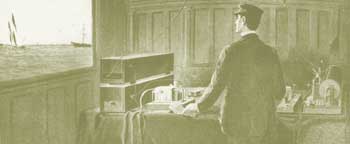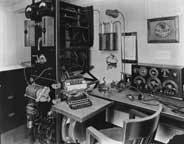| Marconi's
wireless system was based on the work of many earlier scientists, including
Ampere, Faraday, Morse, Edison, Loomis, and Branley. Inspired by Rudolph
Hertz, who first demonstrated the existence of electro-magnetic waves
and showed that they could be detected at a distance, Marconi developed
practical methods to generate and detect "Hertzian Waves."
He applied Morse code to his new system, and set up a business to develop
and market it. The Marconi company monopolized the world radio market
for two decades. |
 |
| Above: Marconi transmitted
news of the America's cup yacht race of 1899 and gained widespread publicity
for the new spark-gap technology. Photo courtesy Mechanic's Institute. |
 |
| The earliest Marconi wireless radio
was a coil of wire which amplified an electrical spark to jump a gap
between two conductors. The spark was controlled by a telegraph key
and the current routed out through an antenna. The waves generated by
this spark could be detected about 300 miles away. Using Morse telegraph
code, words could be spelled out for the first time and ships were able
to communicate considerable distances. Above: A pre-1919 shipboard radio
room with a quench-gap spark transmitter. Photo courtesy California
State Library, S.O.W.P. Collection. |
|